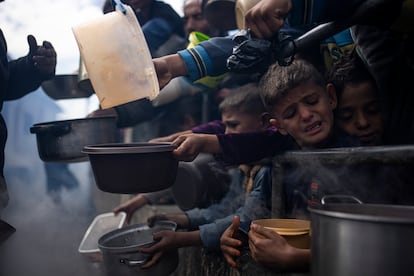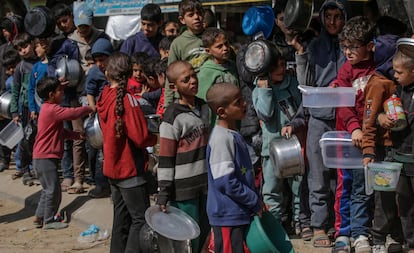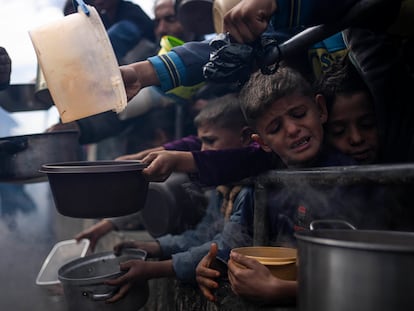Gaza on the brink of starvation: ‘If I get food, it’s once a day’
Half a million people are in the most serious phase of malnutrition, especially in the north of the territory, where some families make bread with animal feed, due to the lack of flour

When a Gazan is asked via WhatsApp what they ate the day before, there is no need to specify whether it was for breakfast, lunch or dinner because it was their only meal of the day. That’s in the best of cases. In the worst, they are one of the half a million people the United Nations considers to be in the most critical of the five phases of food crises: at high risk of dying from starvation. More than 80% of the people in the world who are in this phase — considered “catastrophic” — are currently struggling in Gaza. Especially in the north, where the lack of flour is leading some families to prepare pita bread with ground animal feed and the U.N. World Food Program (WFP) has suspended humanitarian aid, after after a hungry mob attacked its trucks last week.
“In Gaza, there is simply not enough food for everyone. When fate permits and I get it, it is once a day. Other days, I can’t find it, or it’s too expensive and I can’t afford it,” says Tamer Ashraf, 20, who, like many hundreds of thousands of others, escaped from northern Gaza to the city of Khan Younis and then, again by order of the Israeli army, to Rafah, where more than half of Gaza’s 2.3 million population are waiting to be forcibly displaced again ahead of Israel’s planned ground invasion of the area.
All of Gaza is hungry today, to a greater or lesser extent. Some 64% eat only once a day and 95% ration portions or give less to adults so that children have more, according to United Nations data. In the north, the estimated hundreds of thousands of people remaining meet at least one of three indicators signaling famine and are on track to meet the other two, according to the Famine Review Committee, the international team of food security and nutrition experts that analyzes the data. Nutrition checks at shelters and health centers in the north reveal that 15.6% of babies under two years of age are severely malnourished. Before the war, practically none of them were. Three percent are suffering from the most severe type of malnutrition: they will perish if they do not receive urgent help.
The data is captured in images that can be seen daily on television and social media: the fights over a ration when food is distributed, the queues of adults and children extending a plate or any plastic container, the looting of humanitarian aid, the prohibitive prices on the black market, the delight of those who can afford to eat shawarma for the first time in more than four months of war...
The WFP describes its last two attempts to deliver aid to Gaza, and the ensuing chaos that led the organization to suspend deliveries. “On Sunday [February 18], as WFP started the route towards Gaza City, the convoy was surrounded by crowds of hungry people close to the Wadi Gaza checkpoint. First fending off multiple attempts by people trying to climb aboard our trucks, then facing gunfire once we entered Gaza City, our team was able to distribute a small quantity of the food along the way. On Monday, the second convoy’s journey north faced complete chaos and violence due to the collapse of civil order. Several trucks were looted between Khan Younis and Deir al Balah [in the center and south] and a truck driver was beaten. The remaining flour was spontaneously distributed off the trucks in Gaza city, amidst high tension and explosive anger.”
In the statement, the WFP speaks of “unprecedented levels of desperation.” Aid has barely arrived to the north, and the police of the Hamas government, which maintains control in Rafah, refuses to escort trucks transporting aid because Israel bombs the agents, Philippe Lazzarini, the head of the U.N. agency for Palestinian refugees UNRWA, explained in a meeting with journalists at the organization’s headquarters in Jerusalem.

“Very little help arrives here and there is very little food available,” Yahia Sarray, the mayor of the capital of Gaza, says in WhatsApp messages. “People are hungry and can’t find basic things, especially for children and babies. Many only eat one small meal a day. They go looking everywhere for anything they can eat. Sometimes they risk their lives by going to very dangerous places in the hope of getting something edible. What we need most is bread and flour,” he says.
Jeremy Konyndyk, president of Refugees International, an American NGO dedicated to supporting displaced people, refugees and stateless people, warned last Tuesday in a video conference that “nothing can prevent a famine in Gaza” unless there is change. “If an unhindered humanitarian operation is not allowed throughout Gaza, there will be famine. And it will not be because of natural phenomena, but because of the way in which this war is being carried out and the persistent and intentional denials of humanitarian access, mainly by Israel [...] which has only allowed one in five requests for movement in the north.”
Using food as a weapon
In October, shortly after the start of the war, Israeli Defense Minister Yoav Gallant announced a “complete siege” of Gaza blocking food, water, electricity and fuel. “We are fighting human animals and we are acting accordingly,” he said. Under pressure from allies, Israel allowed some humanitarian aid to enter Gaza from Egypt (although it is not Israel’s border, it must give the green light).
Some days fewer than 100 aid trucks enter, compared to the 500 before the war, when farms and industries were also up and running. In recent weeks, moreover, ultranationalist Israeli groups have been trying daily (and at times succeed) to stop the trucks from passing. The Israeli army has also bombed food warehouses, mills and bakeries (15 of the almost 100 are in operation). On January 16, eight U.N. rapporteurs accused Israel of “destroying Gaza’s food system and using food as a weapon against the Palestinian people.” Two days earlier, 15 NGOs — including Action Against Hunger, ActionAid, Plan International and Save the Children — reminded Israel that resolution 2417 of the United Nations Security Council condemns the starving of civilians as a method of warfare.
For weeks, humanitarian aid has been largely limited to the south, where the vast majority of the population is concentrated, hundreds of thousands of them in standard or makeshift tents. They mainly receive bottles of water, flour, baby milk, chickpeas, rice, cooking oil, sugar, canned meat...
In the market, you can buy fresh or packaged products, some of them from before the war. But there is little availability and the need is great, so now these cost up to 10 times more. A kilo of potatoes costs 14 shekels ($3.85, seven times more) and a bag of flour costs 500 shekels (10 times more). On the streets of Rafah, chocolates that were previously available for one or two shekels now cost 12 or 13. “Sometimes we buy the cheapest thing in the market because prices have skyrocketed. A kilo of sugar can cost 20 times more. Others eat what we receive from humanitarian aid. We eat once or twice a day to save money because there is not always food in the market and prices change every day,” says Asma, a young woman from the capital, who has been displaced to Rafah.
International organizations and NGOs are concentrating their efforts in Rafah, so the situation there is less dire, although 5% of children under two years of age have shown signs of acute malnutrition in examinations, according to U.N. data.
Marina Pomares returned on February 13 after working for a month in Rafah as medical coordinator with the Doctors Without Borders Spain project. She says that she did not see “alarming” malnutrition figures, because it was the area with the most access to food, but she did see mothers unable to breastfeed their children. She also had to provide emergency nutritional solutions to vulnerable groups, such as children under five years of age, and pregnant and lactating women. “They have a very similar pattern: lack of food. They tend to consume a lot of legumes, carbohydrates, flour, non-perishable foods... What they lack most are proteins,” she explains. Meat, for example, has been a luxury in Gaza since October 7, when the Hamas attacks triggered the Israeli invasion that has killed some 30,000 people in Gaza, mostly women and minors, and reduced most of its buildings to rubble.
The Israeli government claims that Hamas steals up to 60% of humanitarian aid (which the United Nations has no record of) and blames the crisis on distribution problems. “The bottleneck is not on the Israeli side,” said the military coordinator for Gaza, Moshe Tetro. This idea is repeated in the Israeli media, along with the popular narrative that civilians are also to blame in one way or another for the October 7 attacks, fueling support for plans to further limit aid to force Hamas to hand over the Israeli hostages.
In its latest poll, published last Tuesday, the Israel Democracy Institute (IDI) asked: “Do you support or oppose the idea that Israel should allow the transfer of humanitarian aid to Gaza residents at this time, with food and medicines being transferred by international bodies that are not linked to Hamas or to UNRWA?” Sixty-eight percent of the Jewish population replied that they opposed aid delivery, including 31% of respondents who define themselves as left-wing.
Konyndyk, who headed the humanitarian division of USAID, argues simple steps can be taken to prevent famine in Gaza. “The way to do it is known and has been applied in other places: an immense flow of food,” both in the humanitarian field and in the most important, commercial field. “And they are both blocked right now in Gaza,” he says.
The main problem, says Konyndyk, is that “it is completely impossible to provide an adequate response in the current circumstances and will continue to be so without a ceasefire.” And he points out another two important factors. Firstly, the data are not showing the excess mortality typical of a famine, but the fate of a large majority of people who do not go to hospitals is unknown, especially in the north. Secondly, in a famine, most people do not die from hunger, but from diseases, and today in Gaza, only five of the 35 hospitals are working and 70% of the children suffer from diarrhea. “If there was a cholera outbreak right now, it would spread like wildfire,” he explains.
Sign up for our weekly newsletter to get more English-language news coverage from EL PAÍS USA Edition
Tu suscripción se está usando en otro dispositivo
¿Quieres añadir otro usuario a tu suscripción?
Si continúas leyendo en este dispositivo, no se podrá leer en el otro.
FlechaTu suscripción se está usando en otro dispositivo y solo puedes acceder a EL PAÍS desde un dispositivo a la vez.
Si quieres compartir tu cuenta, cambia tu suscripción a la modalidad Premium, así podrás añadir otro usuario. Cada uno accederá con su propia cuenta de email, lo que os permitirá personalizar vuestra experiencia en EL PAÍS.
¿Tienes una suscripción de empresa? Accede aquí para contratar más cuentas.
En el caso de no saber quién está usando tu cuenta, te recomendamos cambiar tu contraseña aquí.
Si decides continuar compartiendo tu cuenta, este mensaje se mostrará en tu dispositivo y en el de la otra persona que está usando tu cuenta de forma indefinida, afectando a tu experiencia de lectura. Puedes consultar aquí los términos y condiciones de la suscripción digital.
More information
Archived In
Últimas noticias
‘How does it feel to be a failure?’: Elizabeth Berkley’s journey from ‘Showgirls’ ridicule to vindication
The story of the Málaga virus: The code that haunted Google’s cybersecurity center director for 30 years
The impact of Ecuador’s mega-prison: A polluted river, cleared forests and military checkpoints
Corinne Low: ‘I’m more concerned about the female happiness gap than the gender wage gap’
Most viewed
- The low-cost creative revolution: How technology is making art accessible to everyone
- Christian Louboutin: ‘Young people don’t want to be like their parents. And if their parents wear sneakers, they’re going to look for something else’
- All the effects of gentrification in one corner of Mexico’s Colonia Roma
- Liset Menéndez de la Prida, neuroscientist: ‘It’s not normal to constantly seek pleasure; it’s important to be bored, to be calm’
- Christmas loses its festive spirit: ICE fears cast shadow over religious celebrations











































